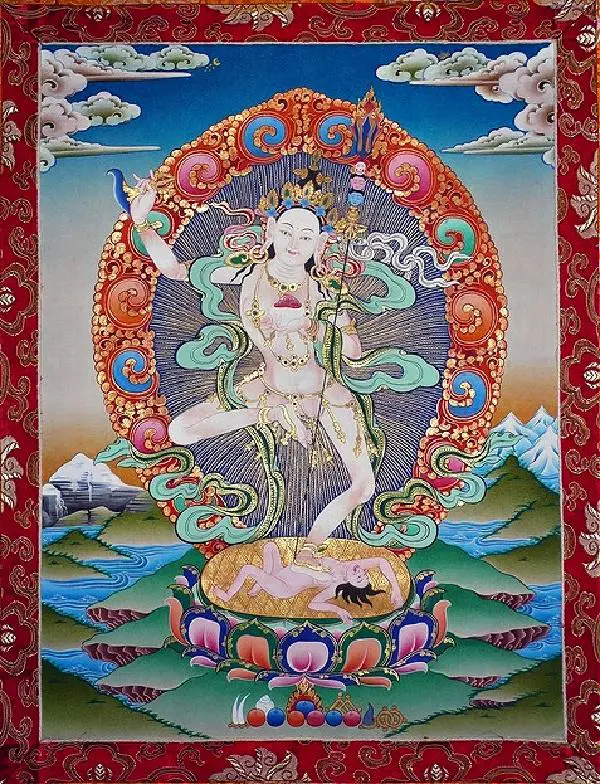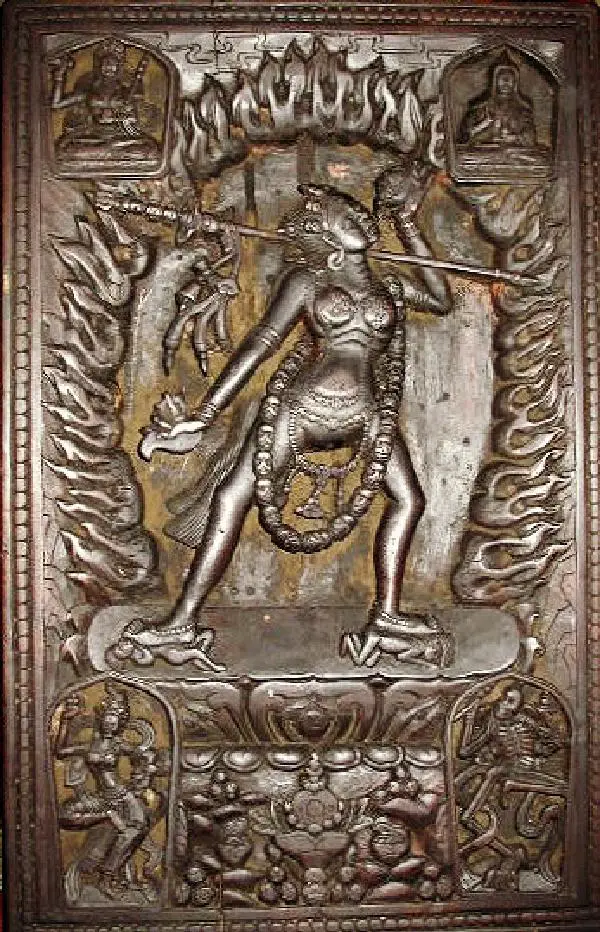A Symbol of awareness, messages, enlightenment, creativity, destruction, transcendent wisdom, clear light, wrath, female energies.
The word Dakini means sky dweller or sky dancer. In Tibetian Buddhism, Dakini is the most sacred aspect of the feminine principle, embodying divinity and humanity in feminine form. Dakinis can be beautiful, ugly, vicious, playful, and nurturing as the context demands. They can be ugly to remind people that inner peace does not always come with outward beauty. Dakinis can be a woman or a goddess, and they can be wrathful or peaceful. They represent the ever-changing flow of energy that a yogi must be able to contain to become actualized.
In Tibetan Buddhism, Dakini are heavenly female messengers, female emanations of the Buddha, and inspirations of the yogi. They symbolize female energy, which is most often creative but sometimes destructive. There are four classes of Dakini, including secret, inner, outer, and outer outer classes. Originally, Dakini were witches and fairies, but then they were taken into Buddhism.
Dakini is separated into four main classes: prajnaparamita, or the secret class; the inner class; the outer class; and the outer class. The secret class of Dakini focuses on the empty nature of reality and the perfection of transcendent wisdom. The inner class is a meditational deity symbolized by the mandala who, like the Buddha, is fully enlightened and helps others experience enlightenment. The outer class of Dakini is symbolized by tantric meditation, creating a body that is as enlightened as the mind. The outer outer class is a Dakini in human form. She may be a consort of a yogi or a yogi herself.

The Trikaya doctrine classifies the Dakini into three classes representing the three bodies of Buddhahood. One of the three classes is the dharmakaya Dakini, where all phenomena appear. Another class is the Sambhogakaya Dakini, which are the meditational deities associated with tantric practices. Last is the Nirmanakaya Dakini, which are special women potentials who are associated with gurus, are realized yoginis, or all women in general.
In Dzogchen, Dakini is the final stage on the Vajrayana path. The Dakini are energies of life as the Base; they are the activities of advanced practitioners as the Path, and as the Fruit, they are the realized Master’s actualized activities.
Dakini is also associated with the clear light in anuttarayoga tantra. People will be embraced by the Dakini when they can transform poisons into illuminated energy and enlightened awareness.

In Japan, the Dakini is often pictured riding a white fox. Emperors and Shoguns venerated Dakini-ten because if they did not worship the Dakini-ten, their kingdoms would be ruined by them. Dakini-ten became associated with black magic, and these spells were used to possess people.
In Hinduism, the Dakini is the name of one of the female deities, or yoginis. Also, Dameshvaranaha is a male deity with female energies. These energies are the Dakini. The Dakini also fight for Shiva against Daksha.
Dakini appears between the moment of wake and sleep and the moment between life and death. When someone transitions between an intellectual approach and a more experiential approach, Dakini will appear.
Symbols Menu:
» Amulet
» Ajna
» Arsenic
» Merkaba
» Hung
» Yin Yang
» bindi
» IK Onkar
» Khanda
» Halo
» jiahu
» Tau
» Uraeus
» Menorah
» Quincunx
» Tilaka
» Taijitu
» Vajra
» Chai
» Chi Rho
» Bagua
» Dragon
» Hunab Ku
» Caduceus
» Infinity
» Ichthus
» Hedjet
» Lauburu
» Om
» Ankh
» Chalice
» Pentacle
» Maat
» Ogham
» Mandala
» Kartika
» Khamsa
» Heart
» Labrys
» Sun Face
» Raven
» Triskele
» Scarab
» Dove
» Hanukia
» Anubis
» Trishula
» Durga
» Mezuzah
» Bay Tree
» Geruda
» Kinnara
» Quito
» Condor
» Blue Jay
» Falcon
» Makara
» Rosary
» Uluru
» Apsaras
» Hanuman
» Serpent
» Minotaur
» Mercury
» Apex
» Vestra
» Yoni
» Astarte
» dakini
» Calabash
» Mandrake
» Rebis
» Typhon
» Vegvísir
